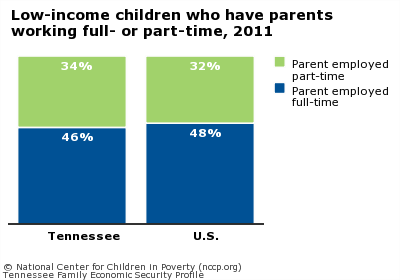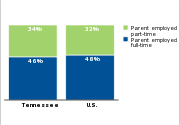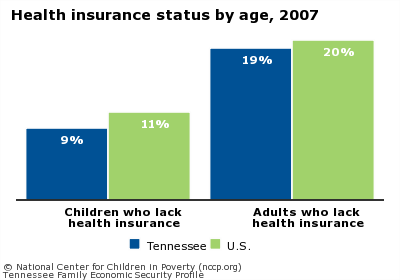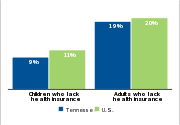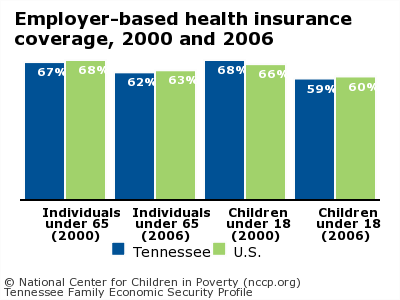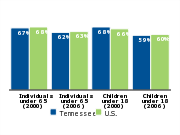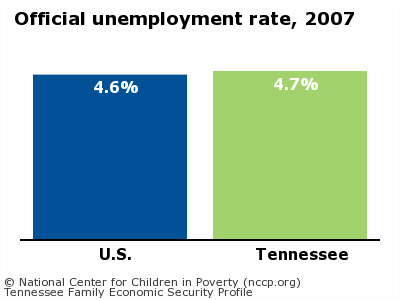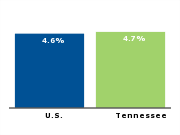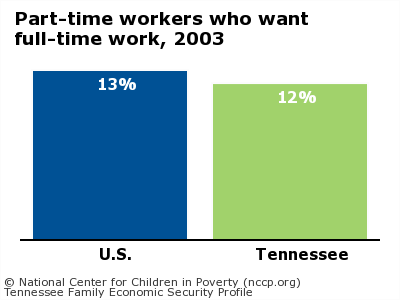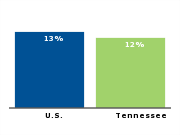State Choices to Promote Child Care Affordability and Access
| Earnings limit for a single-parent family of 31 | | $29,016/year |
| Co-payment as percent of income for family of 3 at 150% FPL, 1 child in care2 | | 8% |
| Providers prohibited from charging additional fees3 | | No |
| Provider payment rates at least 75th percentile of market rate4 | | No |
| Refundable credit available5 | | No state credit |
| Benefit structure5 | | No state credit |
| Max benefit for family with 2 qualifying children5 | | No state credit |
Low-income children who have parents
working full- or part-time, 20116
State Choices to Promote Access to Health Insurance
| Applicant earnings limit for single parent with 2 children8 | | $23,628/year7 |
| Parents eligible up to same limit as children, single parent with 2 children9 | | No7 |
| Legal immigrants otherwise barred from benefits eligible for prenatal care10 | | No7 |
| Medicaid income eligibility limit as % of FPL for children ages 1-5 in family of 312 | | 133%11 |
| Medicaid income eligibility limit as % of FPL for children ages 6-19 in family of 312 | | 100%11 |
| SCHIP (separate program) income eligibility as % of FPL for children in family of 313 | | 250%11 |
Health insurance status by age, 200714
Employer-based health insurance coverage, 2000 and 200615
State Choices to Promote Access to Benefits for the Under- and Unemployed
| State counts most recent earnings when determining eligibility16 | | No |
| Eligible if seeking part-time work17 | | No |
| State has general provision recognizing "good cause" for quitting work18 | | No |
| Earnings limit for a single-parent family of 319 | | $13,092/year |
Official unemployment rate, 200720
Part-time workers who want
full-time work, 200321
Data Notes and Sources
Data were compiled from 50-state sources. Some state policy decisions may have changed since these data were collected.
- Karen Schulman and Helen Blank, State Child Care Assistance Policies 2007: Some Steps Forward, More Progress Needed, National Women's Law Center, September 2007.
- If the state calculates co-payments based on the cost of care, figure reflects the co-payment for a 4-year-old in licensed, nonaccredited center care at the maximum state payment rate.
Karen Schulman and Helen Blank, State Child Care Assistance Policies 2007: Some Steps Forward, More Progress Needed, National Women's Law Center, September 2007.
- Karen Schulman and Helen Blank, Child Care Assistance Policies 2005: States Fail to Make up Lost Ground, Families Continue to Lack Critical Supports, National Women's Law Center, September 2005.
- States were asked to report state reimbursement rates and the 75th percentile of market rates for their state's most populous city, country, or region. Data reflect basic provider payment rates (higher rates may be available for particular types of care). Rates are considered below the 75th percentile if they are based on an out-dated market rate survey (more than 2 years old).
Karen Schulman and Helen Blank, State Child Care Assistance Policies 2007: Some Steps Forward, More Progress Needed, National Women's Law Center, September 2007.
- Nancy Duff Campbell, Joan Entmacher, Amy K. Matsui, Cristina Martin Firvida, and Christie Love. 2006. Making Care Less Taxing: Improving State Child and Dependent Care Tax Provisions, with updates from National Women's Law Center, 2009 Supplement to Making Care Less Taxing. Washington, DC: National Women's Law Center.
- National data were calculated from the 2011 American Community Survey, representing information from 2011. State data were calculated from the 2009-2011 American Community Survey, representing information from the years 2009 to 2011.
- Tennessee was not enrolling eligible parents at any time between July 2007 and January 2009.
- Figure reflects limit under Medicaid plan with highest income eligibility limit for parents, taking into account the value of earnings disregards (which may be time-limited in some cases).
Donna Cohen Ross and Caryn Marks. 2009. Challenges of Providing Health Coverage of Children and Parents in a Recession: A 50-State Update on Eligibility Rules, Enrollment and Renewal Procedures, and Cost-Sharing Practices in Medicaid and SCHIP in 2009, Kaiser Commission on Medicaid and the Uninsured. http://www.kff.org (accessed February 16, 2009).
- Value reflects comparison of applicant earnings limit for a single parent with 2 children to the highest Medicaid or SCHIP program eligibility limit for children ages 6-19.
Donna Cohen Ross and Caryn Marks. 2009. Challenges of Providing Health Coverage of Children and Parents in a Recession: A 50-State Update on Eligibility Rules, Enrollment and Renewal Procedures, and Cost-Sharing Practices in Medicaid and SCHIP in 2009, Kaiser Commission on Medicaid and the Uninsured. http://www.kff.org (accessed February 16, 2009).
- States have the option of using federal State Children's Health Insurance Program (SCHIP) funds to provide prenatal care to women regardless of immigration status. They can also extend prenatal care to immigrant women using state funds.
National Immigration Law Center, Guide to Immigrant Eligibility for Federal Programs, Fourth Edition, 2002; with updates from Update Page, www.nilc.org/pubs/Guide_update.htm (accessed October 17, 2008).
- Tennessee also has a Medicaid waiver program, but enrollment is closed to all new applicants.
- Limit includes SCHIP-funded Medicaid expansions, where applicable.
Donna Cohen Ross and Caryn Marks. 2009. Challenges of Providing Health Coverage of Children and Parents in a Recession: A 50-State Update on Eligibility Rules, Enrollment and Renewal Procedures, and Cost-Sharing Practices in Medicaid and SCHIP in 2009, Kaiser Commission on Medicaid and the Uninsured. http://www.kff.org (accessed February 16, 2009).
- Donna Cohen Ross and Caryn Marks. 2009. Challenges of Providing Health Coverage of Children and Parents in a Recession: A 50-State Update on Eligibility Rules, Enrollment and Renewal Procedures, and Cost-Sharing Practices in Medicaid and SCHIP in 2009, Kaiser Commission on Medicaid and the Uninsured. http://www.kff.org (accessed February 16, 2009).
- Figures reflect the percent of of children (under age 18) and adults (ages 18-64) who did not have health insurance coverage at any point during the year.
Current Population Survey, 2008 Annual Social and Economic Supplement, "Health Insurance Coverage Status and Type of Coverage by State and Age for All People" http://pubdb3.census.gov (accessed September 3, 2008).
- 2000:
Figures reflect the percent of children under age 18 and the percent of adults under 65 who were covered by employer-based health insurance during at least part of the year.
Current Population Survey, 2001 Annual Social and Economic Supplement, "Health Insurance Coverage Status and Type of Coverage by State and Age for All People," http://pubdb3.census.gov (accessed March 5, 2008).
2006:
Figures reflect the percent of children under age 18 and the percent of adults under 65 who were covered by employer-based health insurance during at least part of the year.
Current Population Survey, 2007 Annual Social and Economic Supplement, "Health Insurance Coverage Status and Type of Coverage by State and Age for All People," http://pubdb3.census.gov (accessed March 5, 2008).
- In most states, the base period consists of the first 4 of the 5 most recently completed quarters. Some states allow claimants to use an alternative base period that includes more recent earnings.
U.S. Department of Labor, Office of Workforce Security, Comparison of State UI Laws, 2006, http://www.ows.doleta.gov (accessed July 11, 2007).
- Rick McHugh and Andrew Stettner, How Much Does Unemployment Insurance for Jobless Part Time Workers Cost?, National Employment Law Project, May 2005, http://www.nelp.org (accessed July 13, 2005).
- A general "good cause" provision extends eligibility to persons who leave their jobs for "personal emergencies" or "compelling circumstances", which should include--among others--child care conflicts, illness, domestic violence, and spousal relocation. Eligibility determinations, however, may vary in practice. States may also specifically recognize certain reasons as "good cause"; for more information see Appendix B in Rebecca Smith, Rick McHugh, Andrew Stettner, and Nancy Segal, Between a Rock and a Hard Place: Confronting the Failure of State Unemployment Insurance Systems to Serve Women and Working Families, National Employment Law Project, 2003.
Rebecca Smith, Rick McHugh, Andrew Stettner, and Nancy Segal, Between a Rock and a Hard Place: Confronting the Failure of State Unemployment Insurance Systems to Serve Women and Working Families, National Employment Law Project, July 2003.
- Gretchen Rowe with Jeffrey Versteeg, The Welfare Rules Databook: State Policies as of July 2005, Assessing the New Federalism, The Urban Institute, 2006.
- Figure reflects the percent of people age 16 and above who do not have a job but are available for and actively seeking work.
U.S. Department of Labor, Bureau of Labor Statistics, "Unemployment Rates for States, Annual Average Rankings, 2007," http://www.bls.gov (accessed March 14, 2008).
- Figure reflects the percent of part-time workers who are available to work full-time, but usually work less than 35 hours per week due to slack work or unfavorable business conditions, inability to find full-time work, or seasonal declines in demand.
U.S. Department of Labor, Bureau of Labor Statistics, Geographic Profile of Employment and Unemployment, 2003, "Estimates for States, Table 16: Employed and Unemployed Persons by Full- and Part-Time Status, Sex, Age, Race, and Hispanic or Latino Ethnicity," http://www.bls.gov (accessed March 14, 2008).
